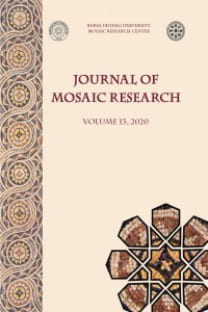Etude pétrographique comparée des tessellata de quelques mosaïques romaines des sites archéologiques de Volubilis et Lixus (Maroc)
Fas'ta yer alan Roma Dönemi'ne ait arkeolojik alanların büyük bir kısmı pek çok mozaik barındırmaktadır. Fas'ta yer alan pek çok farklı arkeolojik alanda, üzerinde mimari yapı bileşenlerinin betimlendiği dikkate değer mozaikler görülmektedir.Volubilis ve Lixus'taki Roma Dönemi'ne ait bazı mozaiklerden alınan tessera örneklerinin petrografik ve mineralojik analizi ile mozaikler üzerinde kullanılan farklı kayaç türleri belirlenmiştir. Tesseraların üretildiği kayaç türlerinin belirlenmesi, materyaller üzerinde kullanılan teknik, ufalanma süreçleri ve kaynaklarının belirlenmesiyle ilgili olarak önemli bir adımdır.Roma mozaiklerinden alınan doğal örnekler üzerinden karşılaştırmalı bir çalışma gerçekleştirilmesiyle yapılarda kullanılan hammadde kaynakları ile hammaddelerin Fas ve Akdeniz'deki yayılımları hakkında fikirler edinilmiştir.Bu çalışma aynı zamanda profesyoneller için restorasyon ve konservasyon esnasında uygulanacak olan müdahalelerle ilgili çözüm önerileri getiren bir rehber niteliği taşımaktadır.
Fas'taki Volubilis ve Lixus Arkeolojik Yerleşimlerine ait Çeşitli Roma Mozaikleri Tesseralarının Karşılaştırmalı Petrografik Çalışması
Most of Roman archaeological sites in Morocco contain many mosaics, it offers significant pavements decorated with the majority of architectural buildings components different archaeological sites of Morocco.Petrographic and mineralogical analyses of tesserae coming from some of Roman mosaics in Volubilis, and Lixus, archaeological sites have revealed the petrographic nature of the rocks used in the decoration of different tessellata. The knowledge of petrographical characteristics of these tesserae represents an essential step to understand mechanical properties of the used materials, their weathering processes and the location of their origin.This comparative study carried on natural materials used in roman mosaics tesselata in some archaeological sites give us ideas about the provenance of building materials and the movement of materials in Morocco and in the Mediterranean region.This study will also provide solutions to guide professionals in the choice of interventions related to the restoration and conservation.
___
- Antonelli et al. 2009 F. Antonelli - L. Lazzarini - S. Cancelliere - D. Dessandier, Volubilis (Meknes, Morocco), "Archaeometric Study of the White and Coloured Marbles Imported in the Roman Age", JCH 10.1, 116-123.
- Dekayir et al. 2004 A. Dekayir - M. Amouric - O. Olives - C. Parron - A. Nadiri - A. Chergui - A. El Hajraoui, "Structure et caractérisation des matériaux utilisés dans la construction d'une mosaïque romaine de la cité de Volubilis (Maroc)", Comptes Rendus Géoscience 336, numéro 12, 1061-1070.
- Dessandier et al. 2008 D. Dessandier - F. Antonelli - R. Bouzidi - M. El Rhoddani - S. Kamel - L. Lazzarini - L. Leroux - M. VartiMatarangas, Guide des pierres du site antique de Volubilis, Maroc, 98-103, 110-118, 124, 143.
- Dott 1964 R.L. Dott, Wacke, "Graywacke and Matrix. What Approach of Immature Sandstone Classification", Journal of Sedimentary Petrology 34, 625-632.
- Dunham 1962 R.J. Dunham, "Classification of Carbonate Rocks according to Depositional Texture", W.E. Hamm (ed.), Classification of Carbonate Rocks, American Association of Petroleum Geologists Memoirs 1, 108-121.
- Faugères 1978 J.C. Faugères, Les Rides sud-rifaines: Evolution sédimentaire et structurale d'un bassin atlantico-mesogéen de la marge africaine. Thèse de Doctorat d'Etat, Université de Bordeaux.
- Folk 1962 R.L. Folk, "Spectral Subdivision of Limestone Types", W.E. Hamm (ed.), Classification of Carbonate Rocks,American Association of Petroleum Geological Memoirs 1, 62-84.
- Limane et al. 1998 H. Limane - R. Rebuffat - D. Drocourt. - G. Rondeau - W. Dubos, Volubilis, de mosaïque à mosaïque.
- Panetier 2002 J. L. Panetier, Volubilis. Une cité du Maroc antique, 108-109.
- Ponsich 1966 M. Ponsich, "Une mosaïque du Dieu Océan à Lixus", BAM 6, 321.
- ISSN: 1309-047X
- Başlangıç: 2008
- Yayıncı: Ululdağ Üniversitesi, Mozaik Araştırlmaları Merkezi
Sayıdaki Diğer Makaleler
Opus Signinum, Terrazzo, Mortier et Béton de Sol :Un Etat de la Question
Abdelilah DEKAYIR, Nissma BOUZOUBAA
The Athena Domus at Apollonia (Albania): A Reassessment
Geometric Analysis of the Mask Mosaic in Metropolis
A Newly Discovered Mosaic from Myrleia
De la nécessité d'identifier précisément le décor géométrique d'une mosaïque. Une étude de cas
